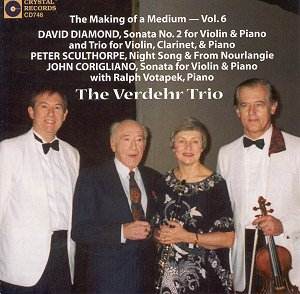Never one to waste a good idea, Sculthorpe often reworks
some of his pieces for various instrumental forces. So, Night-Song
was originally a movement from Love 200 (1970) for orchestra,
two vocalists and rock band. Later Sculthorpe made a version for string
orchestra (1996) and the present version for the Verdehr Trio. The original
version was a setting of words by Tony Morphett and both later versions
retain the song-like quality of the earlier setting. Nourlangie is the
name of an enormous rock monolith in Kakadu National Park which impressed
the composer enough to prompt him to write several pieces inspired by
that site: the guitar concerto Nourlangie (1989), Little
Nourlangie (1990) for organ and orchestra, the orchestral piece
Kakadu (1988) and From Kakadu (1993) for
guitar. From Nourlangie (1993) for piano trio also exists
in a version for soprano and three players, and the present version
for clarinet trio. This short piece is based on a Torres Strait dance-song
of great charm. Both pieces are quite enjoyable and might be ideal either
as concert-openers or as encores.
David Diamond composed his trio in 1994 for the Verdehr
Trio. This is a quite substantial work in four movements of which the
first one is in sonata-allegro form. This is followed by a short, lively
Scherzo whereas the slow movement is a weighty ABA form incorporating
some of the earlier thematic material. The last movement is also the
longest and the weightiest of the whole work. It is also thematically
related to the preceding movements and concludes the trio in grand manner.
Diamondís contrapuntal mastery and earnestness of purpose are prominent
throughout this often complex, utterly serious piece of music.
Diamondís Violin Sonata No.2, in two
fairly equal movements, opens with an unaccompanied Ďcall to armsí for
the violin followed by a secondary slower motif. The whole of the first
movement alternates these germinal motifs with a contrasting long-breathed
violin cantilena. After some further development, the first movement
ends with a slow epilogue. The second movement is also mostly based
on the same thematic material, still further developed. Diamondís Violin
Sonata No.2 is a fine example of this composerís ability to
develop some limited basic material in a startling way.
John Coriglianoís early Violin Sonata
may seem the odd-man-out here; but, as Walter Verdehr remarks, he likes
to play and record works by composers whom he admires and whom he would
like to commission. Hence the inclusion of Diamondís and Coriglianoís
violin sonatas. Coriglianoís work is a youthful work full of optimism
and brimming with instrumental brilliance. A fairly traditional, though
well written and very attractive piece.
At the risk of repeating myself, I will only say that
the present volume is up to the standards set by the other instalments
of this (thank God!) still ongoing series which has much to offer.
Hubert Culot


